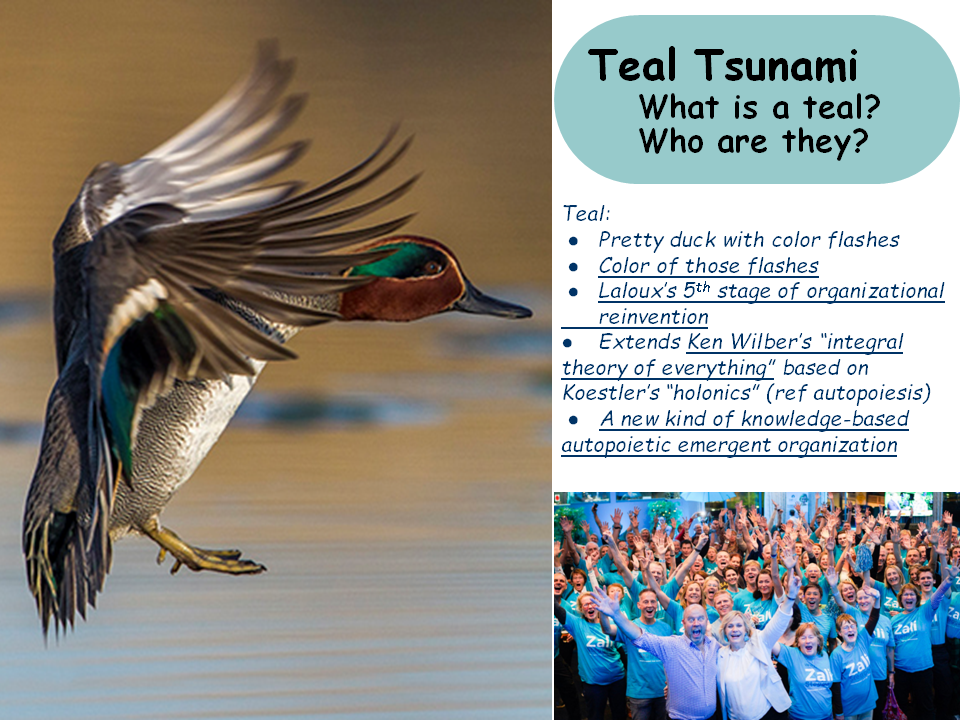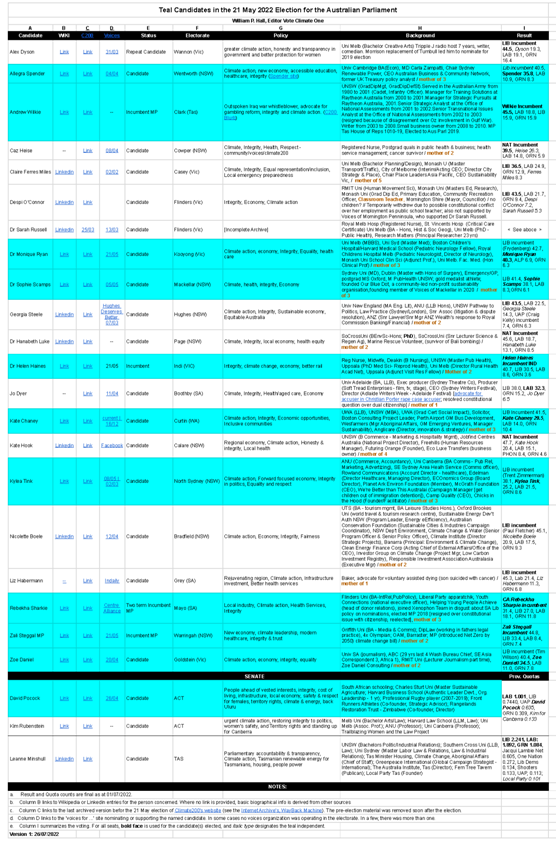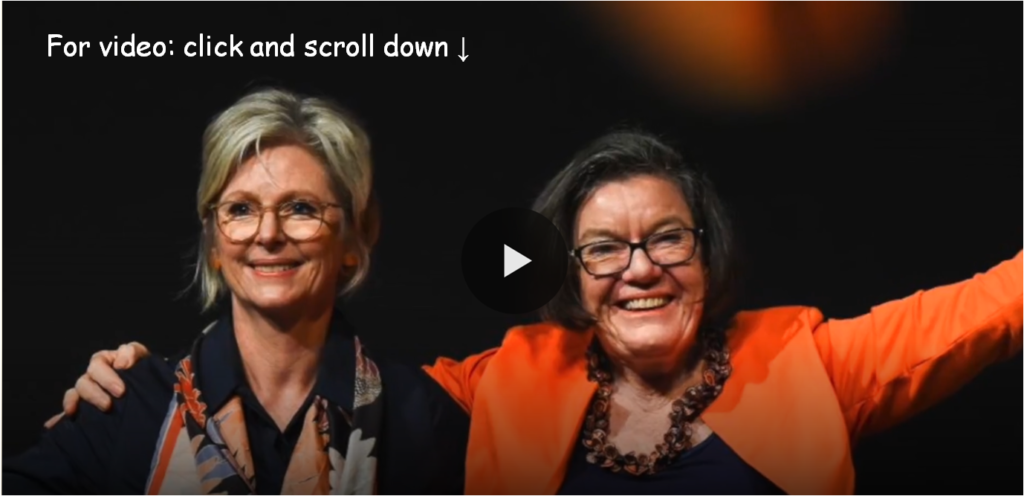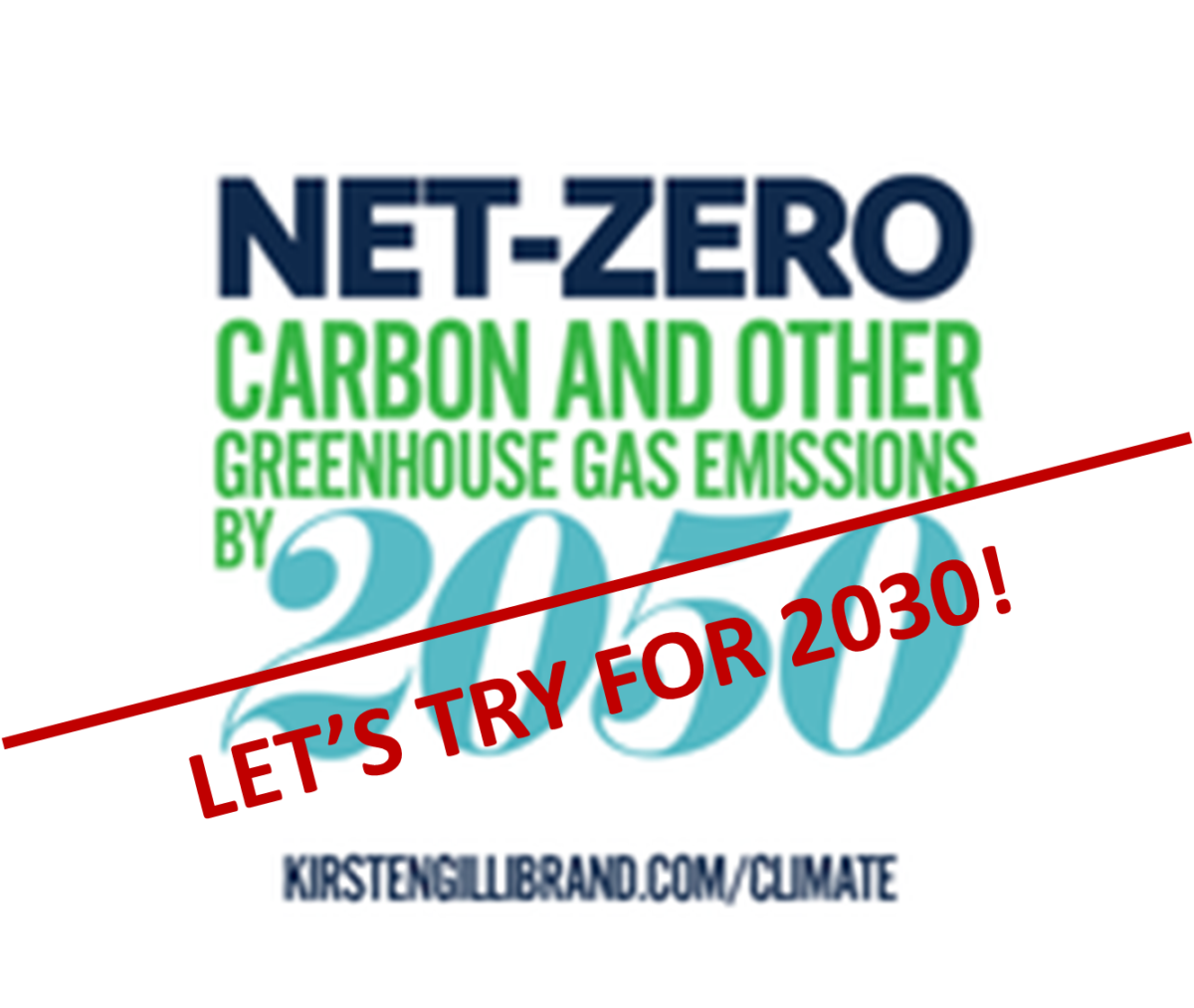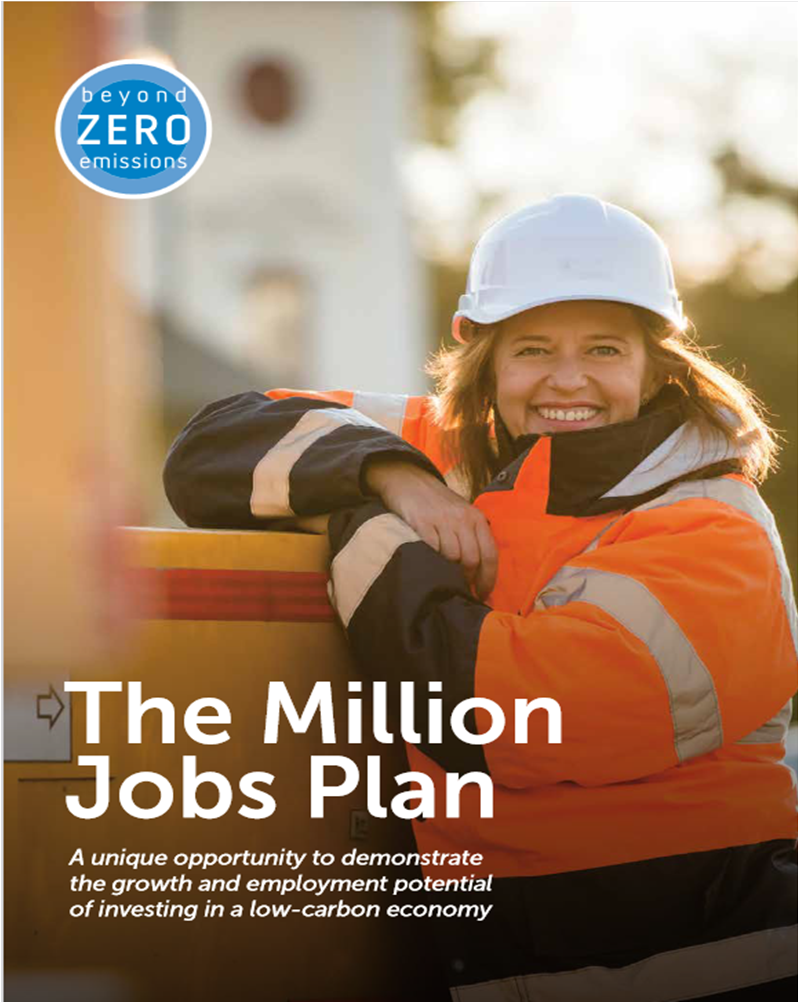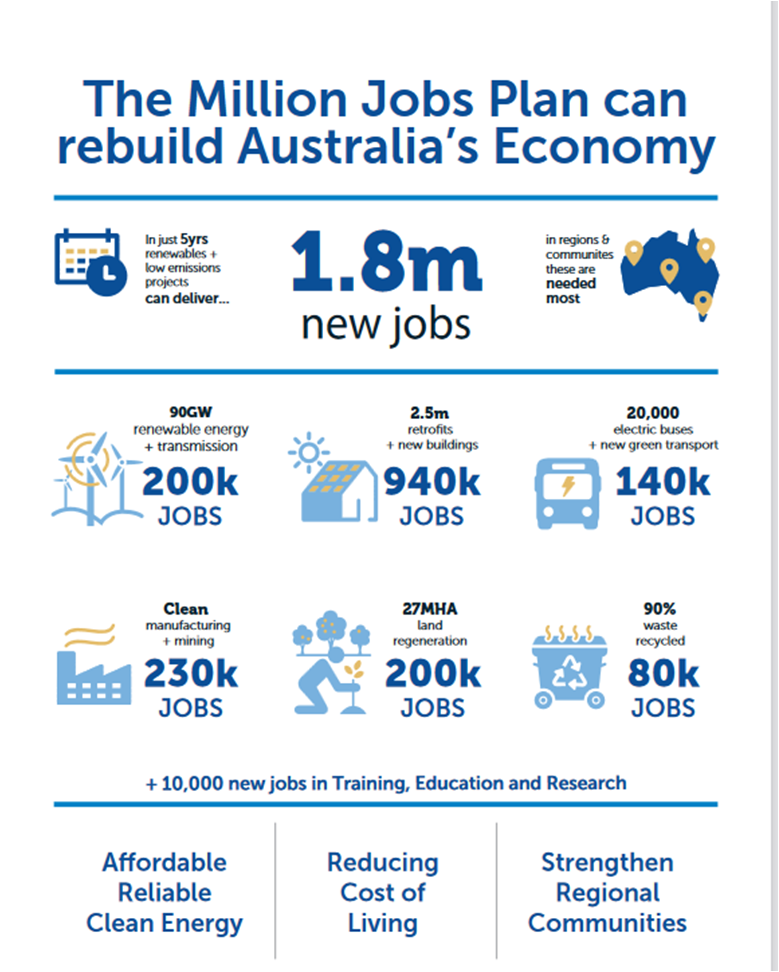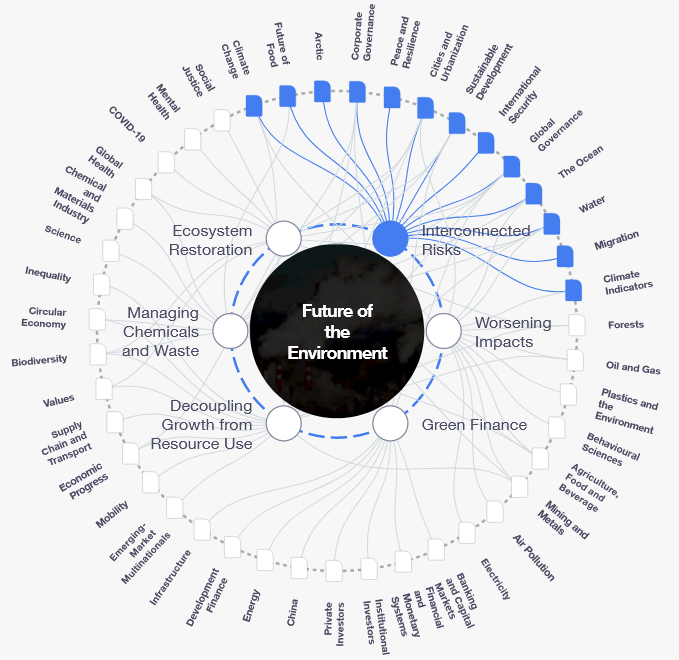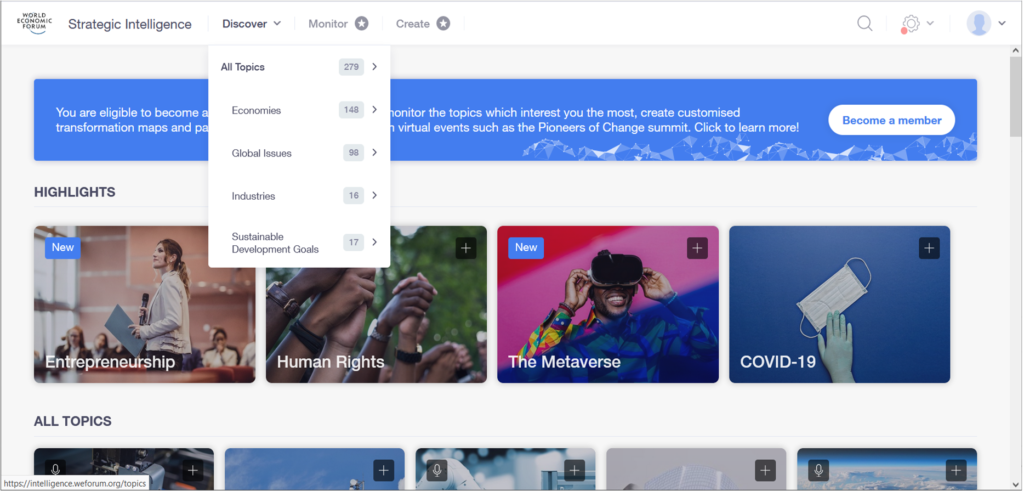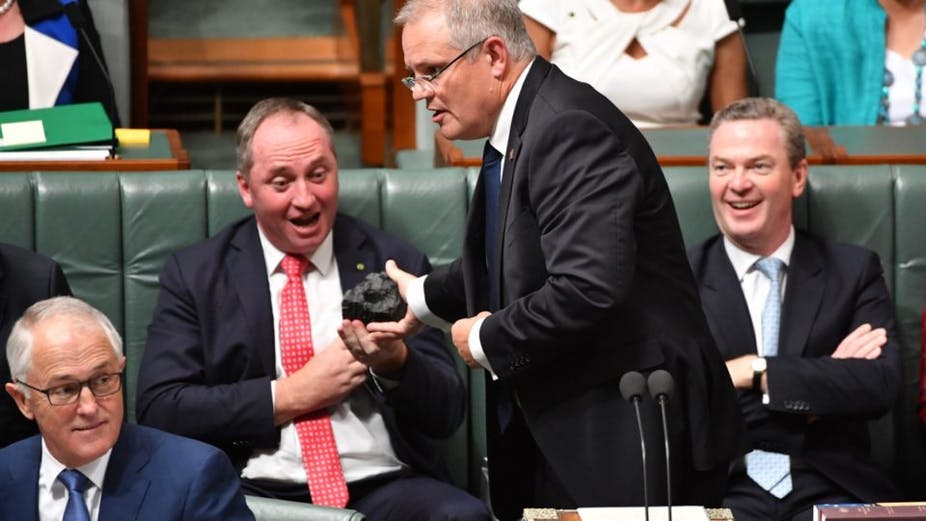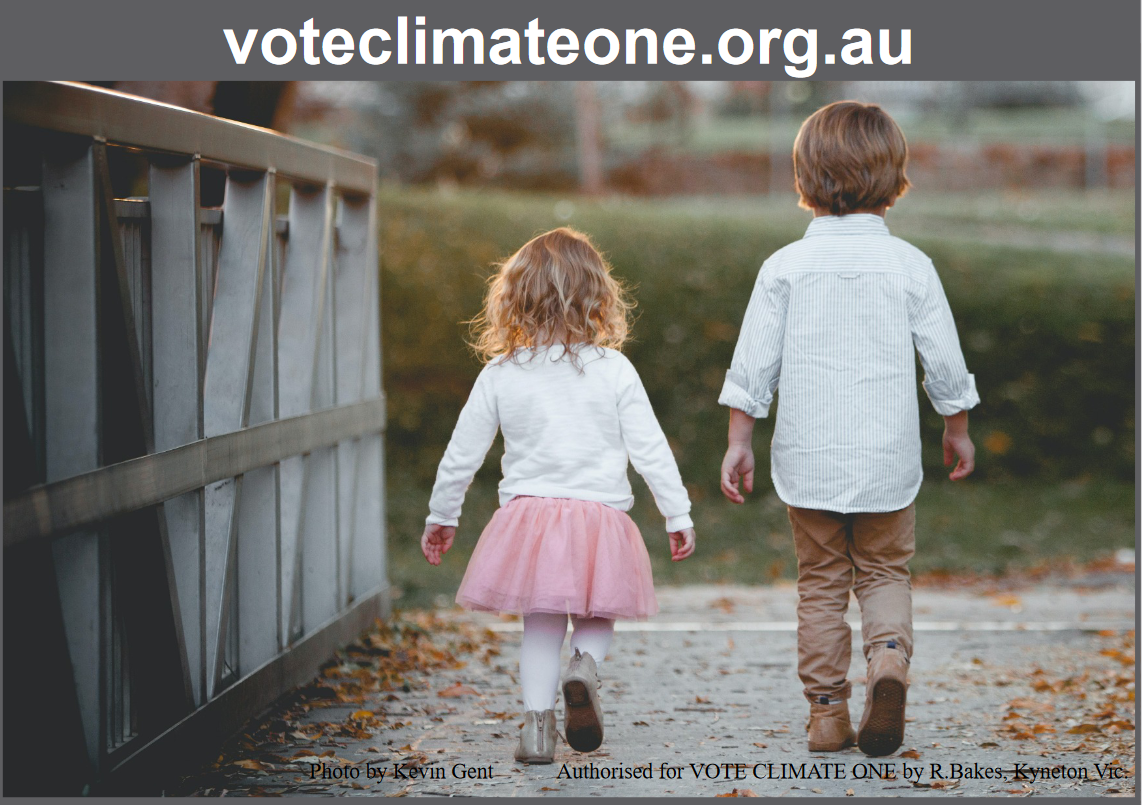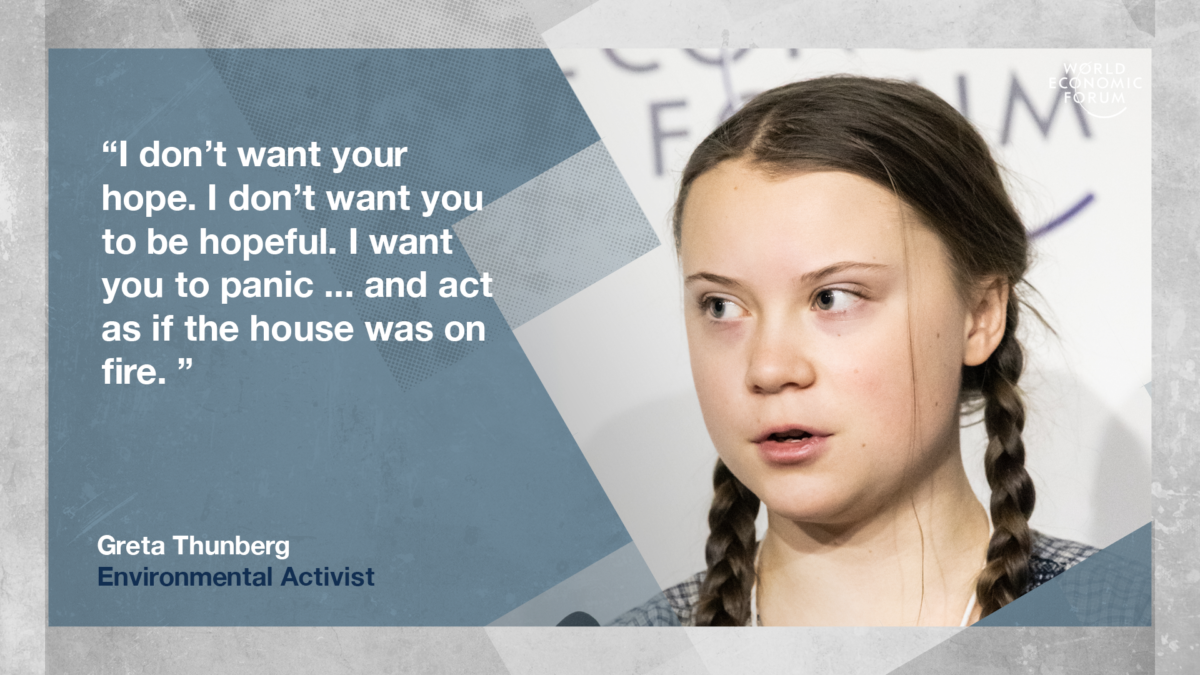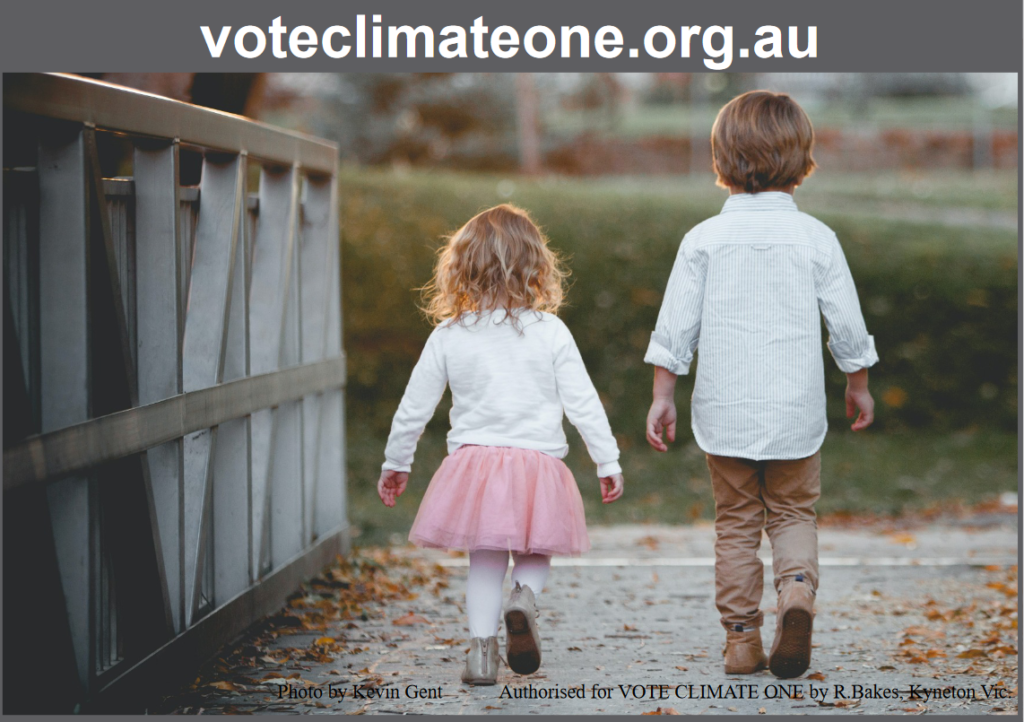Emergence and proliferation of pro-climate community voices: Part 1 – The rising tide of the teal tsunami
Introduction
The results of the 21 May 2022 federal election looks like the beginning of a fundamental revolution in the way politics is done in Australia. Not only has our Parliament shifted from close to a decade of domination by the conservative and reactionary Liberal and National Party Coalition to a more progressive Labor government, but the whole nature of Parliament may be changing. What has been a ‘representative’ democracy dominated by political parties primarily representing the parties’ donors and special interests, may be shifting towards a ‘participatory’ democracy based on independent parliamentarians selected by local communities, and who negotiate with, are endorsed by, and actively represent those communities. Most of the new ‘community independents’ are economically conservative like liberals (generally designated by blue), but more like the Greens in their humanitarian and environmental interests. Hence their designaton as ‘teals’.
In a series of posts I will explore the genesis of the revolution I am calling the ‘Teal Tsunami’: considering the historical circumstances of its origins; the sources, nature, and evolution of the knowledge accounting for the successful election of their candidates; and a theoretical framework for understanding the underlying dynamics of knowledge-based community action groups.
The historical extent of this tsunami so far is illustrated in the following two images showing time lines of particular lower house electorates.
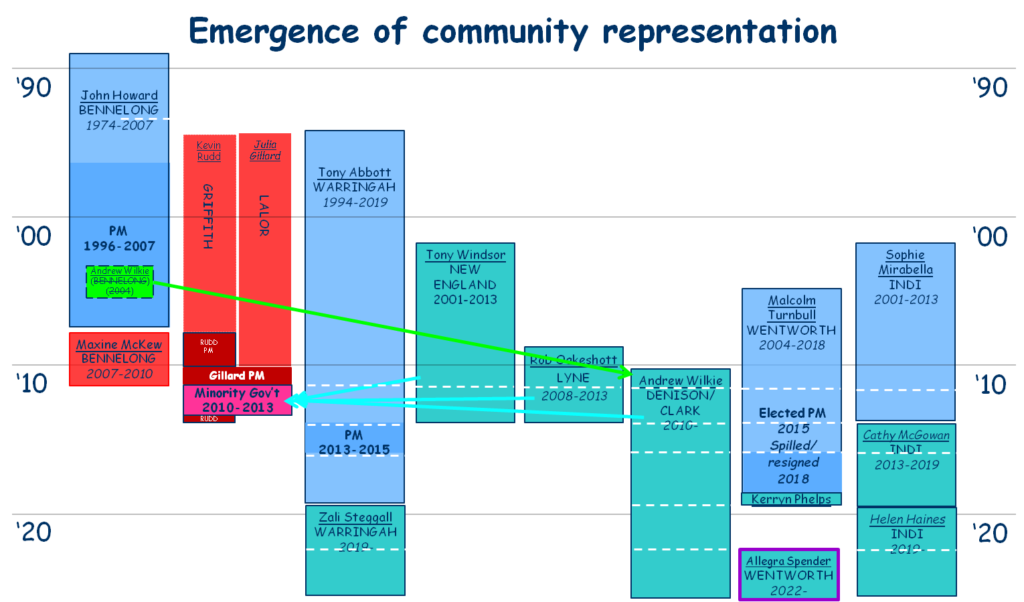
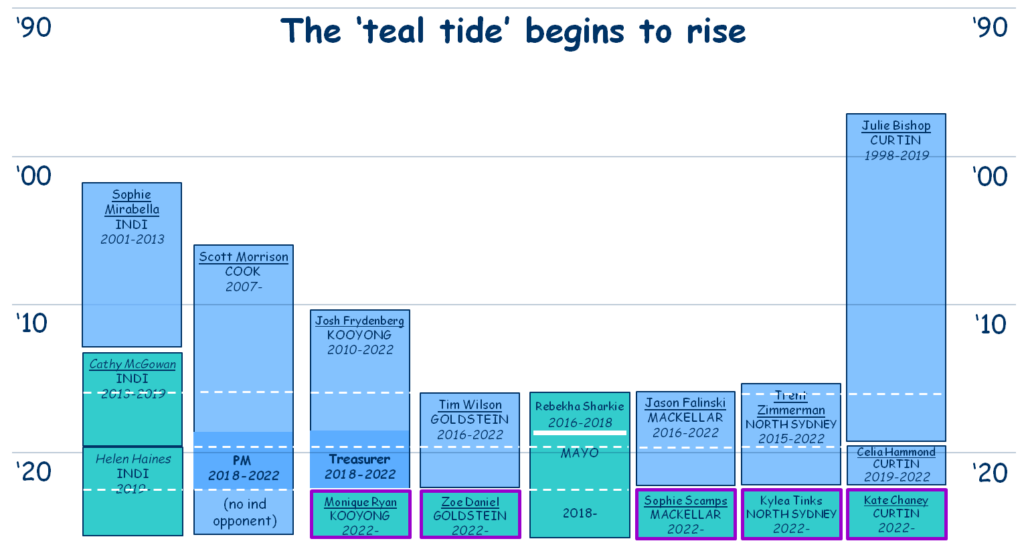
The first major wave (Fig. 2) of the rising tide of the tsunami in the 2022 election just passed removed a significant fraction of then then present and future leadership of the Liberal Party from what had been some of the previously ‘safest’ seats in the Liberal heartland. As I will argue and demonstrate in the series, this success is fueled by a shared body of knowledge developed, tested, and proven by the first generation of teals Cathy McGowan, Helen Haines, Allegra Spender, and even earlier prototypical community independents, Tony Windsor, Rob Oakeshott, and Andrew Wilkie (Figs. 1 & 2). (Note: the roles of shared knowledge and election funding facilitating this result will be detailed in subsequent Parts of this review)
The following Google Sheet details all the teal candidates (elected and otherwise) who ran for the 2022 election and whose campaign funding was assisted by seed and matching funds from the Climate200 organization. All the elected candidates are shaded in teal blue.
Fig. 3. Teal Candidates in the 21 May Election for the Australian Parliament. (Click this link to download a the full legible Google Sheet presenting the data.)
NOTES
- Result and Quota counts are final as at 01/07/2022.
- Column B links to Wikipedia or Linkedin entries for the person concerned. Where no link is provided, basic biographical info is derived from other sources.
- Column C links to the last archived version before the 21 May election of Climate200‘s website (see the Internet Archive’s WayBack Machine). The pre-election material was removed soon after the election.
- Column D links to the ‘voices for …’ site nominating or supporting the named candidate. In some cases no voices organization was operating in the electorate. In a few, there was more than one.Column I summarizes the voting. For all seats, bold face is used for the candidate(s) elected, and italic type designates the teal independent.
- Column I summarizes the voting. For all seats, bold face is used for the candidate(s) elected, and italic type designates the teal independent.
Almost all the teals, whether elected or not, are remarkable women.
That this Teal Revolution is well and truly under way is shown by the fact that the number of climate friendly community independents sitting in Parliament more than doubled in this year’s election at the expense of the Coalition who had controlled government for some 9 years. The teal’s result combined with Labor’s win against the Liberals was a clear signal that voters generally wanted a change to move the pendulum enough to flip many marginal seats. Even given the general swing, the teals decimated leaders’ heartland seats that Labor could never have touched (and turned several more of the seats from safe to marginal).
Where the lower house of Parliament is concerned, Labor won two more seats than the required 75 to form government in its own right, while losing some votes overall (-0.7%). The Coalition was cut by 19 from 77 seats (a majority) to 58 by Liberal losses to Labor, Greens and independents. Only 4 of the remaining Liberal seats were won on first preferences (Barker, Cook – Morrison’s seat, Farrar, and Mitchel; Nationals won 2 seats by first preferences; and QLD LNP won 1. Essentially, the entire Liberal Party is now ‘marginal’. Also, with the elimination of most ‘moderate’ Liberals, Peter Dutton, probably the most hated Liberal still in Parliament, emerged as Leader of the gravely wounded Opposition. This has interesting implications for the next election! By contrast, Labor managed to win 8 seats on first preferences.
The “Cross Bench” more than doubled. The Greens only increased their total national vote by 1.6% but gained 3 new seats in Queensland’s heartland, for a total of 4. Ten of the independent candidates who were elected were assisted by Climate 200 and have promised to prioritize climate action are classified here as ‘teals’ (socially progressive but economically conservative, designated by italicized names). Six “independents” were reelected: Katter, Lambie, Wilkie, Sharkie, Steggal, Haines (4 teals are italicized) – Seven independents were newly elected: Li, Scamps, Tink, Spender, Daniel, Ryan, Chaney (6 are teals). Three more teals (Alex Dyson – WANNON Vic, Caz Heise – COWPER NSW, and Nicolette Boele – BRADFIELD NSW) finished second on first preferences where incumbents failed to gain a majority. Excepting Andrew Wilkie, an ex-intelligence officer reelected for the 5th time, all teals are mothers – several from health professions, a majority have postgraduate qualifications in their professions and are CEO’s, Directors, or Managers of significant enterprises. Mothers would be used to unruly children & cleaning toilets ! – (Labor’s Dr Anne Ali has similar qualities: PhD, Professor at Edith Cowan Uni, researching radicalization, violent extremism and counter terrorism. / mother of 2).
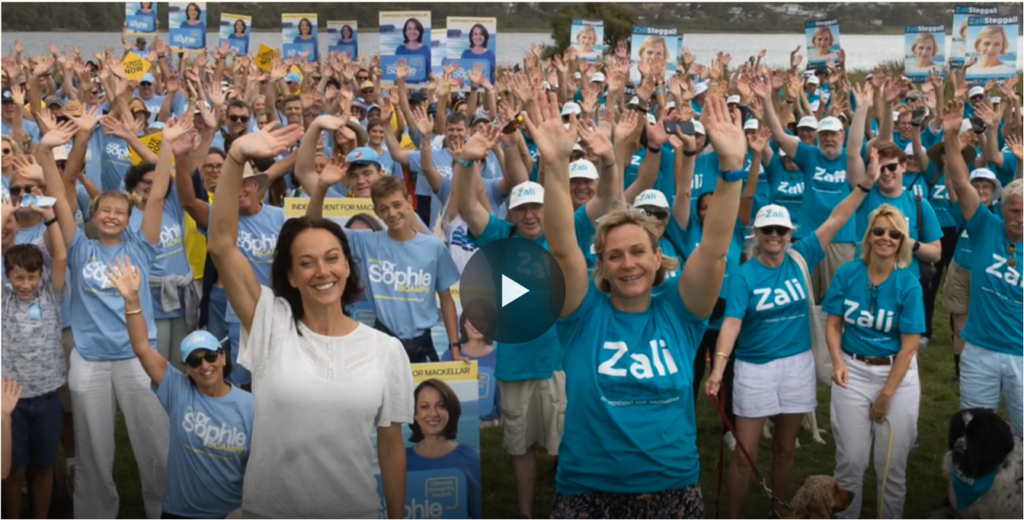
The present article focuses on events leading up to the 2013 Australian Federal Election, especially as it culminated in the emergence of the Voice 4 Indi community action group and their selection, endorsement, and election of one of their founding members, Cathy McGowan in NW Victorian electorate of Indi, one of the safest rural Liberal Party electorates in Australia. As will be detailed in Part 2, Cathy was reelected for two terms, and successfully passed on the community independent baton, to Helen Haines, who was also returned for a second term in this year’s election.
In many ways, McGowan was the prototypical teal. She and the evolving Voice 4 Indi group passed on their successfully tested and re-tested working knowledge to support most of the subsequently established “Voices for ..” community action groups. The body of practical knowledge covers how to involve large communities in the selection, funding, and guidance of candidates and then how to help their endorsed candidates win their elections.
Part 2 of this series will explore how this knowledge emerged in the formation of the Voice 4 Indi community action group and its candidate, Cathy McGowan’s election and reelection to Parliament.
Part 3 will then explore how the successful paradigm established by the Indi group facilitated the establishment of more ‘Voices of ….’ groups whose endorsed candidates have gone on to win several more seats in Parliament – decimating the Liberal Party ranks of present and likely future leadership. This is probably only a foretaste of a much greater revolutionary wave to come with the next federal election.
In Part 4, I will present a theoretical framework for understanding the transformative revolution the teals are making towards replacing government representing political parties’ special interests and patrons, with a ‘participatory democracy’ of government. This is where no party has a majority and government decisions require involvement and assent from ‘community independents’ reflecting the thoughtful wants of the groups they are endorsed by and represent. In the last election, several of the losing Liberals wailed that having independents in the balance of power was a recipe for chaos and catastrophe. Countering this is the fact that the Gillard Minority Government was one of the most successful governments in Australian history measured by the amount of legislation passed in a term or the number of bills passed (see Hung Parliament: Chaos vs Independent Thinking).
Tsunami Warning! The ocean has receded and the teal tide is now rising at an accelerating rate
A desiccating Liberal Party ran into trouble under Howard and temporarily lost control of government
Time-lines of several electorates (Figs 1 & 2) highlight the growing importance of community independents in the in the changing nature of the Australian Parliament in the 21st Century. The story begins with the Liberal/National Coalition Government under PM John Howard becoming increasingly ‘dry‘, as Thatcherite economics, business and their special-interest donors were prioritized ahead of improving the lives of ordinary citizens (to say nothing of how this has been egged on by the growing power of the Murdoch media and their friends). The Sydney Morning Herald’s, 2021 Explainer, Who’s who in the Liberals’ left, right and centre factions? that to me provides evidence for a progressively growing shift in the Party from community representation to factional dogmatism.
Citizens’ concerns over the retreat from humanism and community representation in Coalition government under John Howard probably led to the 24 November 2007 election giving Labor a Parliamentary majority under Kevin Rudd.
Driving the point home that Australians were fed up with Drys and John Howard: Howard was defeated in his own seat of Bennelong by the well known and respected ABC journalist, Maxine McKew. She joined the Labor Party in 2006 after retiring from the ABC and was living with her long-time partner, Bob Hogg, National Secretary of the Labor party from 1988-93.
While in Parliament, McKew was a totally loyal follower of he Labor Party line. In retrospect, it would seem that her election was due more to the fact that she was a credible alternative to Howard for those voters tired of the dry conservatism of the Coalition, than a foretaste of a revolution to come. She lost in the 2013 Election because she offered the electorate nothing more than a rubber stamp for a chaotically under-performing Labor Government under Kevin Rudd. Bennelong was returned to the Liberals in the 21 August 2013 election through McKew’s loss to the well known tennis professional, John Alexander who presented a much milder and human brand of Liberalism than Howard had done.
The first ‘greenish’ community independents are elected
Also in the years before the 2010 election, and giving a foretaste of what was to come in 2013, three already established and socially progressive politicians were elected at different times to Federal Parliament as independent MPs: Tony Windsor (10/11/2001 – 05/08/2013) and Rob Oakeshott (06/09/2008 – 05/08/213) from safe National Party regions in mid-northern NSW, and Andrew Wilkie (21/08/2010 – ) from marginal and mostly urban southern Tasmania.
Tony Windsor‘s political career began in NSW state politics, where he initially intended to run for the National Party representing Tamworth. However, he was dropped by the NP and was elected to the seat as an independent, which he held from 1991 to 2001, when he ran as an independent for the federal electorate of New England, which he held from 2001 until his retirement for health reasons in 2013. In 2016 he re-contested the seat against Barnaby Joyce, but Joyce won comfortably.
Rob Oakeshott also began his political career in NSW state politics as an NP representative in 1996. While in the NP he held several ministerial portfolios, but split from the party as an independent in 2002 over his increasing dissatisfaction with the NP’s social conservatism. Nevertheless, Rob won the 2003 state election with 70% of the primary vote, showing that the community was clearly happy with how he represented them! He retained the seat in 2010 almost as easily. In 2008 Oakeshott resigned his state seat and ran for the Federal seat of Lyne, winning around two-thirds of the primary vote, which he retained in the 2010 election. He retired before the 2013 election. In 2016 he ran for Cowper (which included part of Lyne in a redistribution), and turned the seat marginal although he did not win. He ran again, unsuccessfully, in the 2019 election.
Andrew Wilkie started his professional career as an Army officer, becoming an intelligence officer in the Office of National Assessment. In 2003, in the lead-up to the Iraq War, he resigned from the ONA because he was concerned with the humanitarian consequences of going to war and disagreed with Howard’s push to join the invasion. He stood as a Greens candidate for Bennelong, running against the PM, John Howard in the 2004 Election – achieving nearly 17% of the primary vote. In the 2007 election he stood at second on the Greens Senate ticket for Tasmania, behind Bob Brown, where the Greens failed to win the second quota required to achieve Wilkie’s election. He resigned from the Greens in 2008, citing their lack of professionalism. He then ran in 2010 as an independent in the state seat of Dennison of Hobart, where he narrowly lost; and then in the 2010 federal election for the federal seat of Dennison (same boundaries) where he narrowly won on distribution of preferences.
In a 2010 interview by the ABC, Hobart Mercury columnist Greg Barns described Wilkie’s political situation:
Mr Barns says Mr Wilkie’s public and private battles with some of the institutions he is involved with do not reflect a difficult character, but show that he is a true independent.
“I know Andrew Wilkie very well. I’ve known him now for three or four years and talked policy with him,” he said.
“He’s a deep thinker, he’s a person of great integrity, and I think people of that sort of integrity, it’s not surprising that they might move from an organisation to an organisation.
“I think that’s what that shows about Wilkie – not that he’s a difficult character, simply that he is a person of integrity and he’s finally I think found his natural home, which is to be a true independent.”
https://web.archive.org/web/20100829044014/http://www.abc.net.au/news/stories/2010/08/26/2994143.htm
Wilkie was reelected in each subsequent election where today he still represents the community in the Division of Clark (renamed & slightly redistributed Denison).
Labor takes power in its own right (temporarily)
Despite winning a clear majority of seats in the 2007 election, over the term in Parliament Labor then failed to convince the electorate that they were any better than the Coalition.
Following Wikipedia’s summary, Rudd’s 2007 government ratified the Kyoto Protocol, offered a Parliamentary apology to the “Stolen Generation” and organized the somewhat farcical Australia 2020 Summit (of the 962 recommendations of the summit, only 9 would be adopted). In economic policy, his government re-regulated the labor market by rescinding the Howard government‘s dryish Workchoices reforms and responded to the Global Financial Crisis with a large (and successful) stimulus spending program. Rudd also dismantled the three pillars of the Howard government’s inhumane asylum seeker processing system – offshore processing, temporary protection visas, and turning back unauthorized boats at sea.
Tony Abbott replaced Malcolm Turnbull as the Liberal Party’s Leader of the Opposition in a spill on 1 December 2009. This gave him the maximum opportunity over the following years to give effect to his dogmas and represent his special interests by continuously attacking climate science and all things Labor both on the floor of Parliament and in the press.
Also, on the Labor side, Rudd’s autocratic, abrasive and chaotic leadership style, especially where the Government’s responses to climate issues were concerned, eventually led to a spill motion in the Labor Caucus. Rudd resigned before the spill vote and called for a vote on the leadership. His deputy, Julia Gillard was elected on 24 June 2010 (she received 71 votes to Rudd’s 31). She called an early Federal election for 21 August 2010. This resulted in a ‘hung’ Parliament where Labor and the Coalition each won only 72 seats – 4 short of the 76 required for a clear majority. Gillard was able to marshal pledges of support on supply from the cross-bench (3 independents and one Green) that allowed her to form a stable government. (Note that Philip Chubb’s book – available inexpensively in Kindle, Power Failure: The Inside Story of Climate Politics Under Rudd and Gillard, comprehensively explores this period in history, that will not be detailed here.)
The roles of three independents introduced above, Tony Windsor, Rob Oakeshott, and Andrew Wilkie, in the Gillard minority government represent the first ripple of what has become the ‘teal tsunami’.
The first pro-climate (i.e., ‘teal’) independents show what teals can do in the Gillard-led minority government
Following Labor’s win in the 2007 election under Kevin Rudd, the resulting Government was dogged by Rudd’s ego and chaotic leadership, confounded by party factionalism, culminating in movement towards a spill, leading to Rudd’s resignation on 24 June 2010 hours before the vote was scheduled (see Wikipedia). This gave Julia Gillard leadership for a period leading up to the 2010 federal election, which she called early for 21 August 2010. Labor lost several seats, and the Coalition regained several. Each side won 72 seats in the lower house, 4 short of a majority. The election and its results are detailed in Sims & Wanna (eds, – 2012), Julia 2010 — The caretaker election.
One Green (Adam Bandt) and three community independents, Tony Windsor, Rob Oakeshott, and Andrew Wilkie pledged support for Labor. While the Coalition led by Tony Abbott was only able to obtain two pledges, allowing Labor to form a minority government.
As detailed in my Climate Sentinel News article, Hung Parliament: Chaos vs Independent Thinking, this supposedly hung Parliament, was arguably the first (most legislation passed per unit of time) or second (percentage of legislation passed) most successful Parliament in Australian history in terms of formulating and passing legislation. Led by a woman, all successful Government legislation was developed and negotiated in collaboration with the three independents and one Green — something to think about!
Representative vs Participatory Democracy
There are a vast number of ways large social institutions such as nations can be managed. Most people would hope that their nation is governed in ways they can guide and that will benefit them, their families and acquaintances. Basically, most of us hope our governments are ‘democratic’. There are many different versions of ‘democracy’, and many different ways citizens can be involved in democratic processes. It is beyond me to sensibly explore this diversity, but I strongly recommend reading Wikipedia’s article, Democracy, for a practical survey of the possible forms of democracy.
Australia, from its foundation as an independent country was established as a ‘representative’ democracy with a parliamentary form of government.
Whether this was intended from the outset or not, most representative democracies end up being governed by members of a small number of political parties (usually two main blocks or coalitions) that battle for overall power. In Australia since the end of WWII, this has been between an increasingly dogmatic socially conservative coalition of rural and urban interests giving priority to free markets, economic management (i.e., the Liberal/National Coalition); and a more progressive or even dogmatically socialistic Labor Party or coalition giving priority to providing a better life for unionized workers and ordinary citizens.
To me, the net effect of such party-based ‘representative’ government provides less than ideal outcomes for ordinary citizens, whichever block is in government. This is because would-be representatives of the different parties must compete within their districts to be elected. To win, a competitor must build a substantial campaign organization and expend substantial resources on marketing to win enough votes from eligible voters to be elected. In general, to have much chance of being elected, a candidate requires requires the endorsement of a major party and its support in the form of organizational skills and funding for marketing,
To get this endorsement the candidate must show a high degree of loyalty to the party line, rather than his/her electorate. Almost inevitably, the political party ends up representing what its main financial donors and special (e.g., wealthy capitalists and corporations on the ‘conservative’ side; labor unions and major employers on the ‘progressive’ side) and what they rather than what the general citizens want. Voters thus end up being treated like a market to be harvested for votes that may then be sold to the special interests.
In other words, to win a party listens to its patrons and markets the patrons’ desires to the community; rather than listening to the community and working to achieve what the community wants. Inevitably, to be supported on a continuing basis, party-sponsored MPs must follow the discipline of their parties in the same way that the parties need to follow the ‘disciplines’ demanded by their sponsors.
On the other hand, participatory democracy works to achieve a system whereby citizens have a direct role in selecting and supporting candidates, and in guiding their actions and decisions when once selected. This is much harder to achieve in that there are few if any paradigms to follow that are proven to work, or that don’t quickly degenerate to autocracy or party politics.
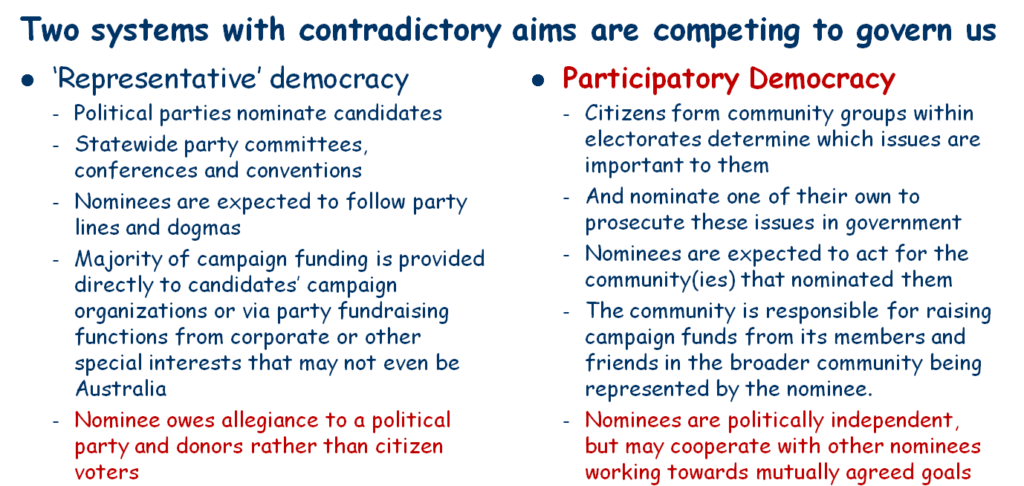
World history suggests that party politics is the default condition / dominant paradigm for representative democracy. As summarized below, the rise of the teals in Australia represents what I think is the beginning of a fundamental revolution or “paradigm shift” in the nature of Australian politics and Government from political party-driven “representative democracy” to what its practitioners in local community action groups (usually known as “Voices of …”) call “participatory democracy“.
The revolution is being driven by the emergence, evolution, and proliferation of a new type of self-sustaining community action group focused on achieving political representation for its members and associates. These action groups, often known as “Voices of …” the particular constituency they represent. By comparison, even though political parties are normally based on local branches to “get out the vote” for their endorsed candidates, they often have little or no effective role in candidate selection or in setting the candidate’s parliamentary agenda. The following graphic based on my own observations summarizes the differences between the two social systems.
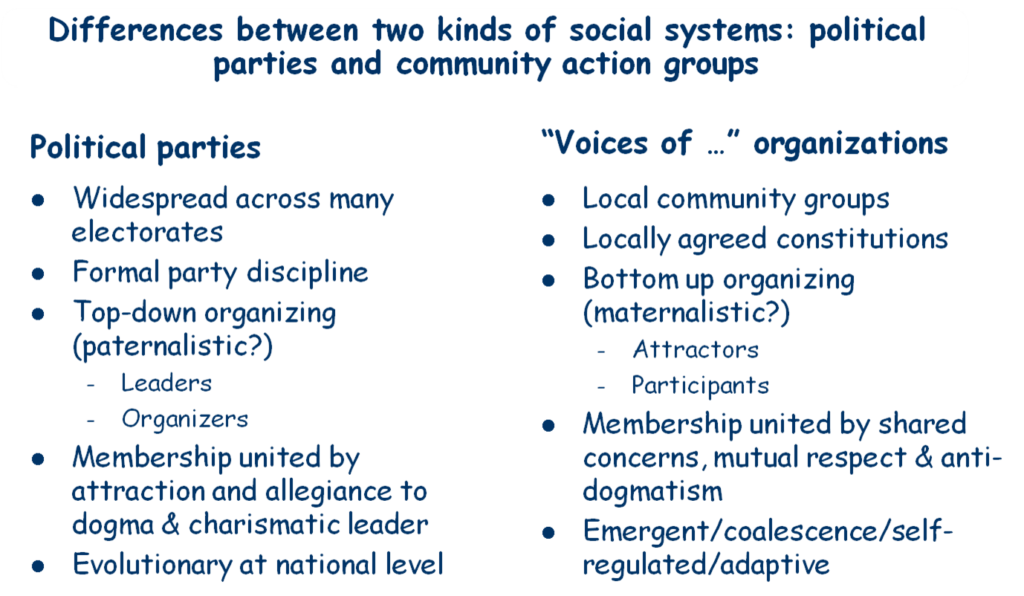
Part 2, takes up the story with the NE Victorian electorate of Indi, where the first self-declared community independent Cathy McGowan replaced the Liberal incumbent, Sophie Mirabella in the 2013 Federal Election, as Tony Abbott’s Liberal led Coalition replaced the Rudd/Gillard/Rudd government.
